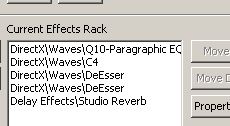Third Principle: Relationship of tempo and genre to reverb
It makes sense to put less reverb to a fast tempo song. It is because in a fast tempo, the notes are short which is inappropriate for a long reverb decay. For example, music like disco or punk rock almost uses no reverb at all.
But for slow songs and ballads; the notes are long and putting moderate amount of reverb can enhance the ambiance of the track particularly for vocals and string instruments.
Rock music on the other hand; needs less reverb than pop ballads. And very fast punk rock music may not have reverb on its instruments at all (except for natural reverberations captured during recording).
How much reverb really?
In my discussion above, I only use subjective terms to define the amount of reverb such as “very little”, “moderate” or “high”. In real application, you are most likely using a reverb plug-in or the reverb feature of your DAW. Then set reverb through decay time in milliseconds (ms). Below are an example of my reverb settings used when mixing common instruments:
Vocals: Adobe Audition 1.5 Studio Reverb, setting: Vocal Reverb (small) preset
I often used this setting for mixing slow female pop songs or ballads. But if the song has fast tempo or upbeat in nature, you can set the decay to less than 1000ms and you should be fine. I also use the Sony FX Reverb and I set it to around 10% to 30% max for rock and moderate tempo music. I love using the plate reverb settings for vocals.
String instruments/violins etc/Guitars – Waves True Verb Stadium Enclosed preset – this is the maximum amount of reverb I used for mixing very slow ballads or instrumental music. For example if the track includes some violin or solo acoustic guitars, I use this setting:
As you have seen, the maximum decay time is set to around 2.7 or 2700ms.
Most of the time for alternative rock music, the maximum amount of reverb I use for guitars instruments will not even exceed 1000ms. It is because rock needs less reverb than other genre. For in-your-face singer/songwriter acoustic performance, I may be using somewhere around 1000ms or even less particularly if the tempo is fast.
All drum parts- less than 1000ms for rock music. Through in some slow ballads, you can put some reverb on snare and hi-hats (~2000ms) but I do not put reverb on kick drum most of the time.
Lastly, use your ear to decide if the reverb is appropriate or not. The above settings are just a starting guide not a permanent solution for your entire mixes. Also as a tip, reverb sounds best if combined with appropriate compression and EQ settings. I always put reverb at the end of the plug-in/effects rack, for example here:
I arranged them with EQ first then compressors and finally the reverb effect.
Content last updated on June 15, 2012


